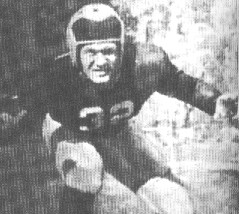Home > History > History Narrative

Georgetown Football History
Chapter 6: The Greatrest Hoya Of Them All
 A fair number of Herculean athletes have competed for Georgetown, but rarely has one combined muscle with modesty as Alfred C. Blozis, Class of 1942. The son of a 300 lb. Lithuanian day laborer, young Al used his awesome physical inheritance to become a four sport star (football, track, swimming, and basketball) at Dickinson High in his home town of Danfield, New Jersey. First recruited by Georgetown, Blozis offered this initial interest as his reason for choosing to enroll at the Hilltop in 1938. His second choice, Notre Dame, was the most prominent loser.
A fair number of Herculean athletes have competed for Georgetown, but rarely has one combined muscle with modesty as Alfred C. Blozis, Class of 1942. The son of a 300 lb. Lithuanian day laborer, young Al used his awesome physical inheritance to become a four sport star (football, track, swimming, and basketball) at Dickinson High in his home town of Danfield, New Jersey. First recruited by Georgetown, Blozis offered this initial interest as his reason for choosing to enroll at the Hilltop in 1938. His second choice, Notre Dame, was the most prominent loser.
Shot putting was Blozis' specialty, and the event in which he would smash records with stunning regularity. Principally a football player in high school, his shot putting began accidentally. Working out by the track one day, Blozis was nearly hit by an errant toss. Angered, he heaved the heavy ball back to the thrower so impressively that the coach immediately placed him on the squad. Blozis went on to set 24 schoolboy track and field records.
Freshman ineligibility rules kept Blozis from competing on the varsity level his first year. Under the tutelage of "Hap" Hardell, veteran Hoya track mentor, Blozis developed a shot putting technique that took maximum advantage of his agile feet and perfectly chiseled 6-5, 250 lb. body. When Blozis began competing as a sophomore, neither coach nor athlete waited long for returns on their time and effort investment.
Blozis romped through the indoor track season and concluded on April 10, 1940 with one of the most amazing feats in the history of track. Going north to Madison Square Garden, Blozis shattered the world indoor marks in three different shot putting events. He hurled the 16 lb. ball 55'- 1", two and a half feet beyond the existing indoor record; the 12 lb. ball three feet over the world mark; and the 8 lb. ball 78'-1/4"-a new record by over eight feet!
Blozis would excel throughout his track career, breaking meet shot put records in 23 of the 26 meets he participated. However, he would never officially hold the absolute world mark in the event's most important category--the 16 lb. shot. Jack Terrance had established the world's record in 1934 with a heave of 57"-1". Blozis best competitive throw was 57' even. At the meet in which me had this toss, Blozis did throw one near 58'; unfortunately, this effort was for a photographer shooting for a magazine, and was not eligible as a record.
It is difficult to believe, but Blozis preferred football over track. Given his immense bulk and strength, it is not difficult to believe that Blozis was an effective, often terrifying, gridder. Clumsy when he first appeared as a Hoya footballer, he matured into an All-American tackle. Known for his violent straight-ahead charges after the snap, opponents frequently tried to "mousetrap" Blozis by running him into a blocker rather than vice versa. These plays initially threatened Blozis, but the problem was soon solved by using his long and powerful arms to tackle both blocker and runner. Impressed by his stellar play, the New York Giants drafted Blozis after he graduated with his Bachelor of Science degree in 1942.
Blozis played for the better part of two seasons with the Giants before leaving for the war in Europe. During that time he was an outstanding performer, being chosen All-Pro, and given special acclaim for his ability to obliterate would-be kick returners in the open field. For his exploits, Blozis was named to the 1940-1949 "All Decade" team.
The saddest aspect of Al Blozis' life was its brevity. Endeared to this country, Blozis sought long and earnestly to obtain a dispensation from military height restrictions. He finally received his wish when inducted into the United States Army on Dec. 9, 1943. During infantry training, he again exhibited his outstanding physical ability by throwing a hand grenade 284'-2 1/2" (95 yards) --nearly three times the previous distance of a normal throw and demolishing the previous record throw easily. Yet, in the end, this attribute did nothing to protect his life. On his first patrol, less than two months after playing his last game on the Gridiron, Lt. Alfred Blozis was killed in the Vosges Mountains during an encounter related to the Battle of the Bulge. Al Blozis was 26 years old.
Blozis' premature death robbed football of a standout player, track and field of a virtually certain Olympic gold medalist, and Georgetown of a devoted alumnus. If it is any indication, he received just recognition of his talent while alive. Most notable is a UPI award selecting Al Blozis one of the three outstanding athletes of 1941.
If you were wondering, the other two were Ben Hogan and Joe Louis.
Excerpted from The HOYA and its 1981-1982 series "Great Moments In Georgetown Sports", by Bill Ferraro. Mr. Ferraro graduated from Georgetown with an A.B. in American Studies in 1982 and received his Ph.D. from Brown University. He is presently a professor at Southern Illinois University.
Home > History > To Chapter 7
HoyaSaxa.com:
The One-Stop Web Site For Hoya Football™
An independent web site not affiliated with Georgetown University. All rights reserved.